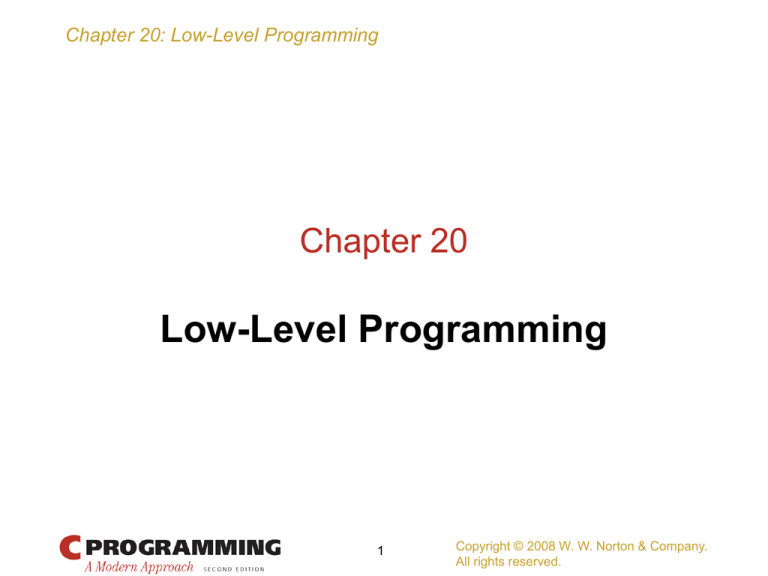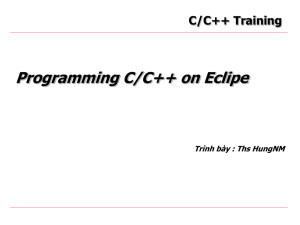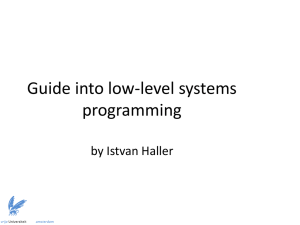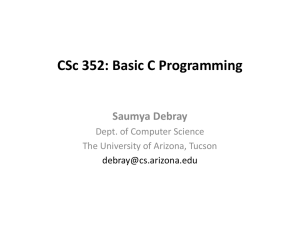
Chapter 20: Low-Level Programming
Chapter 20
Low-Level Programming
1
Copyright © 2008 W. W. Norton & Company.
All rights reserved.
Chapter 20: Low-Level Programming
Introduction
• Previous chapters have described C’s high-level,
machine-independent features.
• However, some kinds of programs need to
perform operations at the bit level:
– Systems programs (including compilers and operating
systems)
– Encryption programs
– Graphics programs
– Programs for which fast execution and/or efficient use
of space is critical
2
Copyright © 2008 W. W. Norton & Company.
All rights reserved.
Chapter 20: Low-Level Programming
Bitwise Operators
• C provides six bitwise operators, which operate on
integer data at the bit level.
• Two of these operators perform shift operations.
• The other four perform bitwise complement,
bitwise and, bitwise exclusive or, and bitwise
inclusive or operations.
3
Copyright © 2008 W. W. Norton & Company.
All rights reserved.
Chapter 20: Low-Level Programming
Bitwise Shift Operators
• The bitwise shift operators shift the bits in an
integer to the left or right:
<< left shift
>> right shift
• The operands for << and >> may be of any integer
type (including char).
• The integer promotions are performed on both
operands; the result has the type of the left
operand after promotion.
4
Copyright © 2008 W. W. Norton & Company.
All rights reserved.
Chapter 20: Low-Level Programming
Bitwise Shift Operators
• The value of i << j is the result when the bits in
i are shifted left by j places.
– For each bit that is “shifted off” the left end of i, a zero
bit enters at the right.
• The value of i >> j is the result when i is shifted
right by j places.
– If i is of an unsigned type or if the value of i is
nonnegative, zeros are added at the left as needed.
– If i is negative, the result is implementation-defined.
5
Copyright © 2008 W. W. Norton & Company.
All rights reserved.
Chapter 20: Low-Level Programming
Bitwise Shift Operators
• Examples illustrating the effect of applying the
shift operators to the number 13:
unsigned short i, j;
i = 13;
/* i is now 13 (binary 0000000000001101) */
j = i << 2;
/* j is now 52 (binary 0000000000110100) */
j = i >> 2;
/* j is now
3 (binary 0000000000000011) */
6
Copyright © 2008 W. W. Norton & Company.
All rights reserved.
Chapter 20: Low-Level Programming
Bitwise Shift Operators
• To modify a variable by shifting its bits, use the
compound assignment operators <<= and >>=:
i = 13;
/* i is now 13 (binary 0000000000001101) */
i <<= 2;
/* i is now 52 (binary 0000000000110100) */
i >>= 2;
/* i is now 13 (binary 0000000000001101) */
7
Copyright © 2008 W. W. Norton & Company.
All rights reserved.
Chapter 20: Low-Level Programming
Bitwise Shift Operators
• The bitwise shift operators have lower precedence
than the arithmetic operators, which can cause
surprises:
i << 2 + 1 means i << (2 + 1), not (i << 2) + 1
8
Copyright © 2008 W. W. Norton & Company.
All rights reserved.
Chapter 20: Low-Level Programming
Bitwise Complement, And,
Exclusive Or, and Inclusive Or
• There are four additional bitwise operators:
~
&
^
|
bitwise complement
bitwise and
bitwise exclusive or
bitwise inclusive or
• The ~ operator is unary; the integer promotions
are performed on its operand.
• The other operators are binary; the usual
arithmetic conversions are performed on their
operands.
9
Copyright © 2008 W. W. Norton & Company.
All rights reserved.
Chapter 20: Low-Level Programming
Bitwise Complement, And,
Exclusive Or, and Inclusive Or
• The ~, &, ^, and | operators perform Boolean
operations on all bits in their operands.
• The ^ operator produces 0 whenever both
operands have a 1 bit, whereas | produces 1.
10
Copyright © 2008 W. W. Norton & Company.
All rights reserved.
Chapter 20: Low-Level Programming
Bitwise Complement, And,
Exclusive Or, and Inclusive Or
• Examples of the ~, &, ^, and | operators:
unsigned short i, j, k;
i = 21;
/* i is now
21 (binary 0000000000010101) */
j = 56;
/* j is now
56 (binary 0000000000111000) */
k = ~i;
/* k is now 65514 (binary 1111111111101010) */
k = i & j;
/* k is now
16 (binary 0000000000010000) */
k = i ^ j;
/* k is now
45 (binary 0000000000101101) */
k = i | j;
/* k is now
61 (binary 0000000000111101) */
11
Copyright © 2008 W. W. Norton & Company.
All rights reserved.
Chapter 20: Low-Level Programming
Bitwise Complement, And,
Exclusive Or, and Inclusive Or
• The ~ operator can be used to help make low-level
programs more portable.
– An integer whose bits are all 1: ~0
– An integer whose bits are all 1 except for the last five:
~0x1f
12
Copyright © 2008 W. W. Norton & Company.
All rights reserved.
Chapter 20: Low-Level Programming
Bitwise Complement, And,
Exclusive Or, and Inclusive Or
• Each of the ~, &, ^, and | operators has a different
precedence:
Highest: ~
&
^
Lowest: |
• Examples:
i & ~j | k means (i & (~j)) | k
i ^ j & ~k means i ^ (j & (~k))
• Using parentheses helps avoid confusion.
13
Copyright © 2008 W. W. Norton & Company.
All rights reserved.
Chapter 20: Low-Level Programming
Bitwise Complement, And,
Exclusive Or, and Inclusive Or
• The compound assignment operators &=, ^=, and
|= correspond to the bitwise operators &, ^, and |:
i = 21;
/* i is now 21 (binary 0000000000010101) */
j = 56;
/* j is now 56 (binary 0000000000111000) */
i &= j;
/* i is now 16 (binary 0000000000010000) */
i ^= j;
/* i is now 40 (binary 0000000000101000) */
i |= j;
/* i is now 56 (binary 0000000000111000) */
14
Copyright © 2008 W. W. Norton & Company.
All rights reserved.
Chapter 20: Low-Level Programming
Using the Bitwise Operators to Access Bits
• The bitwise operators can be used to extract or
modify data stored in a small number of bits.
• Common single-bit operations:
– Setting a bit
– Clearing a bit
– Testing a bit
• Assumptions:
– i is a 16-bit unsigned short variable.
– The leftmost—or most significant—bit is numbered 15
and the least significant is numbered 0.
15
Copyright © 2008 W. W. Norton & Company.
All rights reserved.
Chapter 20: Low-Level Programming
Using the Bitwise Operators to Access Bits
• Setting a bit. The easiest way to set bit 4 of i is to
or the value of i with the constant 0x0010:
i = 0x0000;
/* i is now 0000000000000000 */
i |= 0x0010;
/* i is now 0000000000010000 */
• If the position of the bit is stored in the variable j,
a shift operator can be used to create the mask:
i |= 1 << j;
/* sets bit j */
• Example: If j has the value 3, then 1 << j is
0x0008.
16
Copyright © 2008 W. W. Norton & Company.
All rights reserved.
Chapter 20: Low-Level Programming
Using the Bitwise Operators to Access Bits
• Clearing a bit. Clearing bit 4 of i requires a mask
with a 0 bit in position 4 and 1 bits everywhere
else:
i = 0x00ff;
/* i is now 0000000011111111 */
i &= ~0x0010;
/* i is now 0000000011101111 */
• A statement that clears a bit whose position is
stored in a variable:
i &= ~(1 << j);
/* clears bit j */
17
Copyright © 2008 W. W. Norton & Company.
All rights reserved.
Chapter 20: Low-Level Programming
Using the Bitwise Operators to Access Bits
• Testing a bit. An if statement that tests whether
bit 4 of i is set:
if (i & 0x0010) …
/* tests bit 4 */
• A statement that tests whether bit j is set:
if (i & 1 << j) …
/* tests bit j */
18
Copyright © 2008 W. W. Norton & Company.
All rights reserved.
Chapter 20: Low-Level Programming
Using the Bitwise Operators to Access Bits
• Working with bits is easier if they are given
names.
• Suppose that bits 0, 1, and 2 of a number
correspond to the colors blue, green, and red,
respectively.
• Names that represent the three bit positions:
#define BLUE 1
#define GREEN 2
#define RED
4
19
Copyright © 2008 W. W. Norton & Company.
All rights reserved.
Chapter 20: Low-Level Programming
Using the Bitwise Operators to Access Bits
• Examples of setting, clearing, and testing the
BLUE bit:
i |= BLUE;
i &= ~BLUE;
if (i & BLUE) …
/* sets BLUE bit
*/
/* clears BLUE bit */
/* tests BLUE bit */
20
Copyright © 2008 W. W. Norton & Company.
All rights reserved.
Chapter 20: Low-Level Programming
Using the Bitwise Operators to Access Bits
• It’s also easy to set, clear, or test several bits at
time:
i |= BLUE | GREEN;
/* sets BLUE and GREEN bits
*/
i &= ~(BLUE | GREEN);
/* clears BLUE and GREEN bits */
if (i & (BLUE | GREEN)) …
/* tests BLUE and GREEN bits
*/
• The if statement tests whether either the BLUE
bit or the GREEN bit is set.
21
Copyright © 2008 W. W. Norton & Company.
All rights reserved.
Chapter 20: Low-Level Programming
Using the Bitwise Operators to Access Bit-Fields
• Dealing with a group of several consecutive bits (a
bit-field) is slightly more complicated than
working with single bits.
• Common bit-field operations:
– Modifying a bit-field
– Retrieving a bit-field
22
Copyright © 2008 W. W. Norton & Company.
All rights reserved.
Chapter 20: Low-Level Programming
Using the Bitwise Operators to Access Bit-Fields
• Modifying a bit-field. Modifying a bit-field
requires two operations:
– A bitwise and (to clear the bit-field)
– A bitwise or (to store new bits in the bit-field)
• Example:
i = i & ~0x0070 | 0x0050;
/* stores 101 in bits 4-6 */
• The & operator clears bits 4–6 of i; the | operator
then sets bits 6 and 4.
23
Copyright © 2008 W. W. Norton & Company.
All rights reserved.
Chapter 20: Low-Level Programming
Using the Bitwise Operators to Access Bit-Fields
• To generalize the example, assume that j contains
the value to be stored in bits 4–6 of i.
• j will need to be shifted into position before the
bitwise or is performed:
i = (i & ~0x0070) | (j << 4);
/* stores j in bits 4-6 */
• The | operator has lower precedence than & and
<<, so the parentheses can be dropped:
i = i & ~0x0070 | j << 4;
24
Copyright © 2008 W. W. Norton & Company.
All rights reserved.
Chapter 20: Low-Level Programming
Using the Bitwise Operators to Access Bit-Fields
• Retrieving a bit-field. Fetching a bit-field at the
right end of a number (in the least significant bits)
is easy:
j = i & 0x0007;
/* retrieves bits 0-2 */
• If the bit-field isn’t at the right end of i, we can
first shift the bit-field to the end before extracting
the field using the & operator:
j = (i >> 4) & 0x0007;
/* retrieves bits 4-6 */
25
Copyright © 2008 W. W. Norton & Company.
All rights reserved.
Chapter 20: Low-Level Programming
Program: XOR Encryption
• One of the simplest ways to encrypt data is to
exclusive-or (XOR) each character with a secret
key.
• Suppose that the key is the & character.
• XORing this key with the character z yields the \
character:
00100110 (ASCII code for &)
XOR 01111010 (ASCII code for z)
01011100 (ASCII code for \)
26
Copyright © 2008 W. W. Norton & Company.
All rights reserved.
Chapter 20: Low-Level Programming
Program: XOR Encryption
• Decrypting a message is done by applying the
same algorithm:
00100110 (ASCII code for &)
XOR 01011100 (ASCII code for \)
01111010 (ASCII code for z)
27
Copyright © 2008 W. W. Norton & Company.
All rights reserved.
Chapter 20: Low-Level Programming
Program: XOR Encryption
• The xor.c program encrypts a message by
XORing each character with the & character.
• The original message can be entered by the user or
read from a file using input redirection.
• The encrypted message can be viewed on the
screen or saved in a file using output redirection.
28
Copyright © 2008 W. W. Norton & Company.
All rights reserved.
Chapter 20: Low-Level Programming
Program: XOR Encryption
• A sample file named msg:
Trust not him with your secrets, who, when left
alone in your room, turns over your papers.
--Johann Kaspar Lavater (1741-1801)
• A command that encrypts msg, saving the
encrypted message in newmsg:
xor <msg >newmsg
• Contents of newmsg:
rTSUR HIR NOK QORN _IST UCETCRU, QNI, QNCH JC@R
GJIHC OH _IST TIIK, RSTHU IPCT _IST VGVCTU.
--lINGHH mGUVGT jGPGRCT (1741-1801)
29
Copyright © 2008 W. W. Norton & Company.
All rights reserved.
Chapter 20: Low-Level Programming
Program: XOR Encryption
• A command that recovers the original message
and displays it on the screen:
xor <newmsg
30
Copyright © 2008 W. W. Norton & Company.
All rights reserved.
Chapter 20: Low-Level Programming
Program: XOR Encryption
• The xor.c program won’t change some
characters, including digits.
• XORing these characters with & would produce
invisible control characters, which could cause
problems with some operating systems.
• The program checks whether both the original
character and the new (encrypted) character are
printing characters.
• If not, the program will write the original
character instead of the new character.
31
Copyright © 2008 W. W. Norton & Company.
All rights reserved.
Chapter 20: Low-Level Programming
xor.c
/* Performs XOR encryption */
#include <ctype.h>
#include <stdio.h>
#define KEY '&'
int main(void)
{
int orig_char, new_char;
while ((orig_char = getchar()) != EOF) {
new_char = orig_char ^ KEY;
if (isprint(orig_char) && isprint(new_char))
putchar(new_char);
else
putchar(orig_char);
}
}
return 0;
32
Copyright © 2008 W. W. Norton & Company.
All rights reserved.
Chapter 20: Low-Level Programming
Bit-Fields in Structures
• The bit-field techniques discussed previously can
be tricky to use and potentially confusing.
• Fortunately, C provides an alternative: declaring
structures whose members represent bit-fields.
33
Copyright © 2008 W. W. Norton & Company.
All rights reserved.
Chapter 20: Low-Level Programming
Bit-Fields in Structures
• Example: How DOS stores the date at which a file
was created or last modified.
• Since days, months, and years are small numbers,
storing them as normal integers would waste
space.
• Instead, DOS allocates only 16 bits for a date,
with 5 bits for the day, 4 bits for the month, and 7
bits for the year:
34
Copyright © 2008 W. W. Norton & Company.
All rights reserved.
Chapter 20: Low-Level Programming
Bit-Fields in Structures
• A C structure that uses bit-fields to create an
identical layout:
struct file_date {
unsigned int day: 5;
unsigned int month: 4;
unsigned int year: 7;
};
• A condensed version:
struct file_date {
unsigned int day: 5, month: 4, year: 7;
};
35
Copyright © 2008 W. W. Norton & Company.
All rights reserved.
Chapter 20: Low-Level Programming
Bit-Fields in Structures
• The type of a bit-field must be either int,
unsigned int, or signed int.
• Using int is ambiguous; some compilers treat the
field’s high-order bit as a sign bit, but others
don’t.
• In C99, bit-fields may also have type _Bool.
• C99 compilers may allow additional bit-field
types.
36
Copyright © 2008 W. W. Norton & Company.
All rights reserved.
Chapter 20: Low-Level Programming
Bit-Fields in Structures
• A bit-field can be used in the same way as any
other member of a structure:
struct file_date fd;
fd.day = 28;
fd.month = 12;
fd.year = 8;
/* represents 1988 */
• Appearance of the fd variable after these
assignments:
37
Copyright © 2008 W. W. Norton & Company.
All rights reserved.
Chapter 20: Low-Level Programming
Bit-Fields in Structures
• The address operator (&) can’t be applied to a bitfield.
• Because of this rule, functions such as scanf
can’t store data directly in a bit-field:
scanf("%d", &fd.day);
/*** WRONG ***/
• We can still use scanf to read input into an
ordinary variable and then assign it to fd.day.
38
Copyright © 2008 W. W. Norton & Company.
All rights reserved.
Chapter 20: Low-Level Programming
How Bit-Fields Are Stored
• The C standard allows the compiler considerable
latitude in choosing how it stores bit-fields.
• The rules for handling bit-fields depend on the
notion of “storage units.”
• The size of a storage unit is implementationdefined.
– Typical values are 8 bits, 16 bits, and 32 bits.
39
Copyright © 2008 W. W. Norton & Company.
All rights reserved.
Chapter 20: Low-Level Programming
How Bit-Fields Are Stored
• The compiler packs bit-fields one by one into a
storage unit, with no gaps between the fields, until
there’s not enough room for the next field.
• At that point, some compilers skip to the
beginning of the next storage unit, while others
split the bit-field across the storage units.
• The order in which bit-fields are allocated (left to
right or right to left) is also implementationdefined.
40
Copyright © 2008 W. W. Norton & Company.
All rights reserved.
Chapter 20: Low-Level Programming
How Bit-Fields Are Stored
• Assumptions in the file_date example:
– Storage units are 16 bits long.
– Bit-fields are allocated from right to left (the first bitfield occupies the low-order bits).
• An 8-bit storage unit is also acceptable if the
compiler splits the month field across two storage
units.
41
Copyright © 2008 W. W. Norton & Company.
All rights reserved.
Chapter 20: Low-Level Programming
How Bit-Fields Are Stored
• The name of a bit-field can be omitted.
• Unnamed bit-fields are useful as “padding” to
ensure that other bit-fields are properly positioned.
• A structure that stores the time associated with a
DOS file:
struct file_time {
unsigned int seconds: 5;
unsigned int minutes: 6;
unsigned int hours: 5;
};
42
Copyright © 2008 W. W. Norton & Company.
All rights reserved.
Chapter 20: Low-Level Programming
How Bit-Fields Are Stored
• The same structure with the name of the
seconds field omitted:
struct file_time {
unsigned int : 5;
/* not used */
unsigned int minutes: 6;
unsigned int hours: 5;
};
• The remaining bit-fields will be aligned as if
seconds were still present.
43
Copyright © 2008 W. W. Norton & Company.
All rights reserved.
Chapter 20: Low-Level Programming
How Bit-Fields Are Stored
• The length of an unnamed bit-field can be 0:
struct s {
unsigned int a: 4;
unsigned int : 0;
unsigned int b: 8;
};
/* 0-length bit-field */
• A 0-length bit-field tells the compiler to align the
following bit-field at the beginning of a storage unit.
– If storage units are 8 bits long, the compiler will allocate 4 bits
for a, skip 4 bits to the next storage unit, and then allocate 8 bits
for b.
– If storage units are 16 bits long, the compiler will allocate 4 bits
for a, skip 12 bits, and then allocate 8 bits for b.
44
Copyright © 2008 W. W. Norton & Company.
All rights reserved.
Chapter 20: Low-Level Programming
Other Low-Level Techniques
• Some features covered in previous chapters are
used often in low-level programming.
• Examples:
– Defining types that represent units of storage
– Using unions to bypass normal type-checking
– Using pointers as addresses
• The volatile type qualifier was mentioned in
Chapter 18 but not discussed because of its lowlevel nature.
45
Copyright © 2008 W. W. Norton & Company.
All rights reserved.
Chapter 20: Low-Level Programming
Defining Machine-Dependent Types
• The char type occupies one byte, so characters
can be treated as bytes.
• It’s a good idea to define a BYTE type:
typedef unsigned char BYTE;
• Depending on the machine, additional types may
be needed.
• A useful type for the x86 platform:
typedef unsigned short WORD;
46
Copyright © 2008 W. W. Norton & Company.
All rights reserved.
Chapter 20: Low-Level Programming
Using Unions to Provide Multiple Views of Data
• Unions can be used in a portable way, as shown in
Chapter 16.
• However, they’re often used in C for an entirely
different purpose: viewing a block of memory in
two or more different ways.
• Consider the file_date structure described
earlier.
• A file_date structure fits into two bytes, so
any two-byte value can be thought of as a
file_date structure.
47
Copyright © 2008 W. W. Norton & Company.
All rights reserved.
Chapter 20: Low-Level Programming
Using Unions to Provide Multiple Views of Data
• In particular, an unsigned short value can be
viewed as a file_date structure.
• A union that can be used to convert a short integer
to a file date or vice versa:
union int_date {
unsigned short i;
struct file_date fd;
};
48
Copyright © 2008 W. W. Norton & Company.
All rights reserved.
Chapter 20: Low-Level Programming
Using Unions to Provide Multiple Views of Data
• A function that prints an unsigned short
argument as a file date:
void print_date(unsigned short n)
{
union int_date u;
}
u.i = n;
printf("%d/%d/%d\n", u.fd.month,
u.fd.day, u.fd.year + 1980);
49
Copyright © 2008 W. W. Norton & Company.
All rights reserved.
Chapter 20: Low-Level Programming
Using Unions to Provide Multiple Views of Data
• Using unions to allow multiple views of data is
especially useful when working with registers,
which are often divided into smaller units.
• x86 processors have 16-bit registers named AX,
BX, CX, and DX.
• Each register can be treated as two 8-bit registers.
– AX is divided into registers named AH and AL.
50
Copyright © 2008 W. W. Norton & Company.
All rights reserved.
Chapter 20: Low-Level Programming
Using Unions to Provide Multiple Views of Data
• Writing low-level applications for x86-based
computers may require variables that represent
AX, BX, CX, and DX.
• The goal is to access both the 16- and 8-bit
registers, taking their relationships into account.
– A change to AX affects both AH and AL; changing AH
or AL modifies AX.
• The solution is to set up two structures:
– The members of one correspond to the 16-bit registers.
– The members of the other match the 8-bit registers.
51
Copyright © 2008 W. W. Norton & Company.
All rights reserved.
Chapter 20: Low-Level Programming
Using Unions to Provide Multiple Views of Data
• A union that encloses the two structures:
union {
struct {
WORD ax, bx, cx, dx;
} word;
struct {
BYTE al, ah, bl, bh, cl, ch, dl, dh;
} byte;
} regs;
52
Copyright © 2008 W. W. Norton & Company.
All rights reserved.
Chapter 20: Low-Level Programming
Using Unions to Provide Multiple Views of Data
• The members of the word structure will be
overlaid with the members of the byte structure.
– ax will occupy the same memory as al and ah.
• An example showing how the regs union might
be used:
regs.byte.ah = 0x12;
regs.byte.al = 0x34;
printf("AX: %hx\n", regs.word.ax);
• Output:
AX: 1234
53
Copyright © 2008 W. W. Norton & Company.
All rights reserved.
Chapter 20: Low-Level Programming
Using Unions to Provide Multiple Views of Data
• Note that the byte structure lists al before ah.
• When a data item consists of more than one byte,
there are two logical ways to store it in memory:
– Big-endian: Bytes are stored in “natural” order (the
leftmost byte comes first).
– Little-endian: Bytes are stored in reverse order (the
leftmost byte comes last).
• x86 processors use little-endian order.
54
Copyright © 2008 W. W. Norton & Company.
All rights reserved.
Chapter 20: Low-Level Programming
Using Unions to Provide Multiple Views of Data
• We don’t normally need to worry about byte
ordering.
• However, programs that deal with memory at a
low level must be aware of the order in which
bytes are stored.
• It’s also relevant when working with files that
contain non-character data.
55
Copyright © 2008 W. W. Norton & Company.
All rights reserved.
Chapter 20: Low-Level Programming
Using Pointers as Addresses
• An address often has the same number of bits as
an integer (or long integer).
• Creating a pointer that represents a specific
address is done by casting an integer to a pointer:
BYTE *p;
p = (BYTE *) 0x1000;
/* p contains address 0x1000 */
56
Copyright © 2008 W. W. Norton & Company.
All rights reserved.
Chapter 20: Low-Level Programming
Program: Viewing Memory Locations
• The viewmemory.c program allows the user to
view segments of computer memory.
• The program first displays the address of its own
main function as well as the address of one of its
variables.
• The program next prompts the user to enter an
address (as a hexadecimal integer) plus the
number of bytes to view.
• The program then displays a block of bytes of the
chosen length, starting at the specified address.
57
Copyright © 2008 W. W. Norton & Company.
All rights reserved.
Chapter 20: Low-Level Programming
Program: Viewing Memory Locations
• Bytes are displayed in groups of 10 (except for the
last group).
• Bytes are shown both as hexadecimal numbers
and as characters.
• Only printing characters are displayed; other
characters are shown as periods.
• The program assumes that int values and
addresses are stored using 32 bits.
• Addresses are displayed in hexadecimal.
58
Copyright © 2008 W. W. Norton & Company.
All rights reserved.
Chapter 20: Low-Level Programming
viewmemory.c
/* Allows the user to view regions of computer memory */
#include <ctype.h>
#include <stdio.h>
typedef unsigned char BYTE;
int main(void)
{
unsigned int addr;
int i, n;
BYTE *ptr;
printf("Address of main function: %x\n", (unsigned int) main);
printf("Address of addr variable: %x\n", (unsigned int) &addr);
59
Copyright © 2008 W. W. Norton & Company.
All rights reserved.
Chapter 20: Low-Level Programming
printf("\nEnter a (hex) address: ");
scanf("%x", &addr);
printf("Enter number of bytes to view: ");
scanf("%d", &n);
printf("\n");
printf(" Address
Bytes
Characters\n");
printf(" ------- ----------------------------- ----------\n");
60
Copyright © 2008 W. W. Norton & Company.
All rights reserved.
Chapter 20: Low-Level Programming
ptr = (BYTE *) addr;
for (; n > 0; n -= 10) {
printf("%8X ", (unsigned int) ptr);
for (i = 0; i < 10 && i < n; i++)
printf("%.2X ", *(ptr + i));
for (; i < 10; i++)
printf("
");
printf(" ");
for (i = 0; i < 10 && i < n; i++) {
BYTE ch = *(ptr + i);
if (!isprint(ch))
ch = '.';
printf("%c", ch);
}
printf("\n");
ptr += 10;
}
return 0;
}
61
Copyright © 2008 W. W. Norton & Company.
All rights reserved.
Chapter 20: Low-Level Programming
Program: Viewing Memory Locations
• Sample output using GCC on an x86 system running Linux:
Address of main function: 804847c
Address of addr variable: bff41154
Enter a (hex) address: 8048000
Enter number of bytes to view: 40
Address
------8048000
804800A
8048014
804801E
Bytes
----------------------------7F 45 4C 46 01 01 01 00 00 00
00 00 00 00 00 00 02 00 03 00
01 00 00 00 C0 83 04 08 34 00
00 00 C0 0A 00 00 00 00 00 00
Characters
---------.ELF......
..........
........4.
..........
• The 7F byte followed by the letters E, L, and F identify the
format (ELF) in which the executable file was stored.
62
Copyright © 2008 W. W. Norton & Company.
All rights reserved.
Chapter 20: Low-Level Programming
Program: Viewing Memory Locations
• A sample that displays bytes starting at the address of addr:
Address of main function: 804847c
Address of addr variable: bfec5484
Enter a (hex) address: bfec5484
Enter number of bytes to view: 64
Address
------BFEC5484
BFEC548E
BFEC5498
BFEC54A2
BFEC54AC
BFEC54B6
BFEC54C0
Bytes
----------------------------84 54 EC BF B0 54 EC BF F4 6F
68 00 34 55 EC BF C0 54 EC BF
08 55 EC BF E3 3D 57 00 00 00
00 00 A0 BC 55 00 08 55 EC BF
E3 3D 57 00 01 00 00 00 34 55
EC BF 3C 55 EC BF 56 11 55 00
F4 6F 68 00
Characters
---------.T...T...o
h.4U...T..
.U...=W...
....U..U..
.=W.....4U
..<U..V.U.
.oh.
• When reversed, the first four bytes form the number
BFEC5484, the address entered by the user.
63
Copyright © 2008 W. W. Norton & Company.
All rights reserved.
Chapter 20: Low-Level Programming
The volatile Type Qualifier
• On some computers, certain memory locations are
“volatile.”
• The value stored at such a location can change as a
program is running, even though the program
itself isn’t storing new values there.
• For example, some memory locations might hold
data coming directly from input devices.
64
Copyright © 2008 W. W. Norton & Company.
All rights reserved.
Chapter 20: Low-Level Programming
The volatile Type Qualifier
• The volatile type qualifier allows us to inform
the compiler if any of the data used in a program
is volatile.
• volatile typically appears in the declaration of
a pointer variable that will point to a volatile
memory location:
volatile BYTE *p;
/* p will point to a volatile byte */
65
Copyright © 2008 W. W. Norton & Company.
All rights reserved.
Chapter 20: Low-Level Programming
The volatile Type Qualifier
• Suppose that p points to a memory location that
contains the most recent character typed at the
user’s keyboard.
• A loop that obtains characters from the keyboard
and stores them in a buffer array:
while (buffer not full) {
wait for input;
buffer[i] = *p;
if (buffer[i++] == '\n')
break;
}
66
Copyright © 2008 W. W. Norton & Company.
All rights reserved.
Chapter 20: Low-Level Programming
The volatile Type Qualifier
• A sophisticated compiler might notice that this
loop changes neither p nor *p.
• It could optimize the program by altering it so that
*p is fetched just once:
store *p in a register;
while (buffer not full) {
wait for input;
buffer[i] = value stored in register;
if (buffer[i++] == '\n')
break;
}
67
Copyright © 2008 W. W. Norton & Company.
All rights reserved.
Chapter 20: Low-Level Programming
The volatile Type Qualifier
• The optimized program will fill the buffer with
many copies of the same character.
• Declaring that p points to volatile data avoids this
problem by telling the compiler that *p must be
fetched from memory each time it’s needed.
68
Copyright © 2008 W. W. Norton & Company.
All rights reserved.









